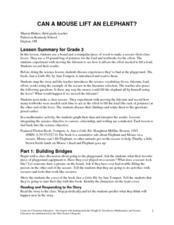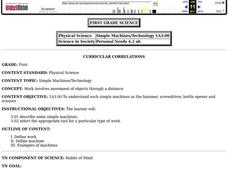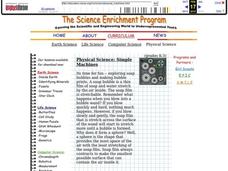Curated OER
Welcome to the Wonderful World of Machines
Designed for a lower elementary school classroom, this presentation on simple machines is a wonderful way to introduce this topic. The resource begins by identifying and defining the six types of simple machines, and then goes on to...
Curated OER
Matching Types of Simple Machines
In this matching types of simple machines worksheet, 5th graders read the definition and examples of simple machines, then match 10 pictures of devices with 4 categories.
Curated OER
Understanding Simple Machines
In this simple machines worksheet, students read about various types of simple machines. They then use what they learned to answer 17 questions. The answers are on the last page.
Curated OER
Can a Mouse Lift an Elephant?
Read Just a Little Bit, by Ann Tompert as an introduction to levers. Discuss playground seesaws and then turn learners loose to experiment with the placement of a fulcrum. Their goal is to determine where to place it in order to lift ten...
Curated OER
Simple Machines
First graders study and describe simple machines such as the hammer, screwdriver, nutcracker, bottle opener and scissors and select the appropriate tool for a particular type of work.
Curated OER
An Invitation to Simple Machines
Third graders explore simple machines as a way of helping the principle with a hurt foot manuever his way around the campus.
Curated OER
Simple Machines-Lever
Students examine the lever. In this simple machines instructional activity, students construct a lever by using two pencils, three pennies, and a ruler. Students explore the uses of a lever.
Curated OER
Simple Machines
Students discover what simple machines are and identify a gear, a pulley, and a lever. In teams, they build at least two models each of simple machines and challenge them with specific instruction cards. Finally, students present and...
Curated OER
Simple Machines/Technology/ Force
Third graders study and define force. They determine that the cause of movement is pushing or pulling which are the types of force used when operating simple machines. They experiment to determine which object requires the most amount of...
Curated OER
What is a Class One Lever?
Fifth graders understand what a lever is, how it works and what the parts of a lever are. In this first class lever lesson, 5th graders label pictures and design a lab lever. Students predict the outcome of experiments with their lever...
Curated OER
How Does a Lever Work?
In this lever worksheet, students read and do the 8 detailed steps in an investigation about levers. Students answer 2 essay questions and record their data on a chart.
Curated OER
Make Work Easier!
Pupils work in pairs to design a lever. They conduct experiments using a penny and nickel to explore the uses of a lever.
Curated OER
Make a Lever
Students investigate how to make a lever. In this construction lesson plan, students explore how to construct a lever using dog and tail templates, cardboard, and fasteners. Students construct their simple machine in order to learn about...
Curated OER
Science-- "Moving the World?"- Learning About Levers
In this levers worksheet, students read a one page information text about the three classes of levers. Students then analyze 10 pictures of simple machines and circle the fulcrum point. Students classify each machine according to the...
Curated OER
Children's Literature Across the Curriculum Ideas-The Gadget War
Students read The Gadget War by Betsy Duffey. They complete a variety of cross-curricular activities surrounding inventors and inventions. Included are reading, art, math, science, writing, social studies, and library connections.
















